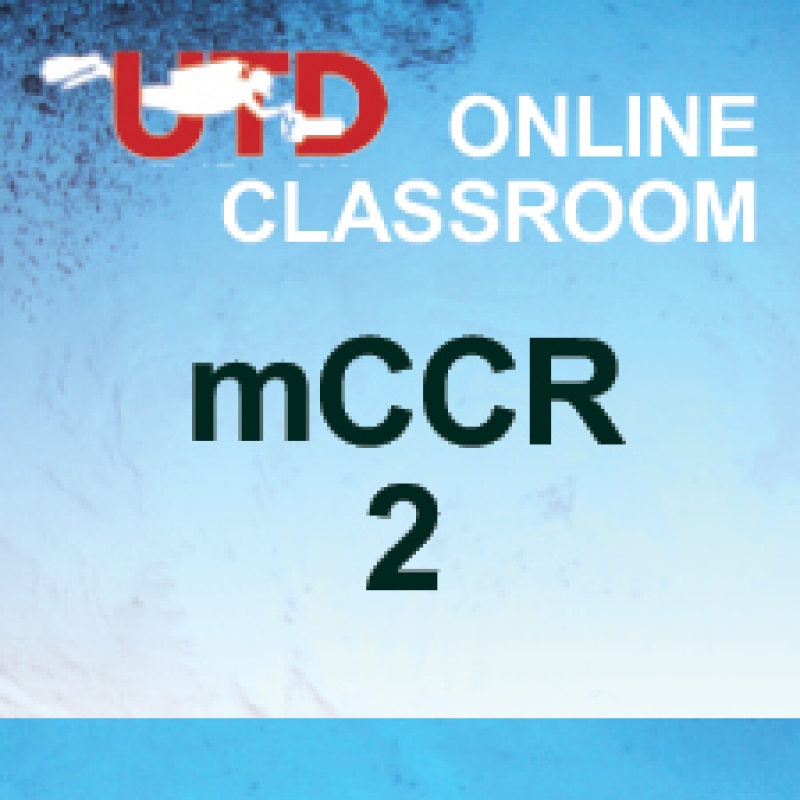Purpose
The UTD mCCR Rebreather Diver 2 course is designed to further educate individuals in the use of MC rebreather technology as it applies to technical diving depth limits and decompression and will make divers proficient in the use of fully-closed circuit technologies while diving mixes (Helitrox) that allow divers to push beyond the recreational depth limits, and allows divers to gain practical experience with their rebreather while learning to apply its use to their extended range activities. This course will cover using the fully closed rebreather in technical diving range while using a single bottle for bailout decompression.
Prerequisites
- Must be a minimum age of 21 years of age.
- Must have completed the online UTD mCCR Rebreather classroom and test
- Must have completed UTD mCCR Rebreather 1 (or equivalent) and UTD Technical Diver or equivalent.
- Must have at least 200 scuba dives beyond open water qualification. 50 must have been in doubles, with 100 using Rebreathers.
- Must have 100 hours on a Rebreather
- Must be able to swim a distance of at least 60 feet/18 meters on a breath hold.
- Must be able to swim at least 300 yards/275 meters in less than 12 minutes without stopping.
Course Limits
- Student to Instructor ratio is not to exceed 4:1 during any in-water training.
- Maximum depth 160 feet / 48 meters.
Course Content
The mCCR Rebreather Diver 2 course is normally conducted over a 5-day period, and cumulatively involves a minimum of 40 hours of instruction designed to provide a working knowledge of rebreather diving, including history, design, function, failures, tables, and operational considerations while using helitrox mixes that allow the diver to go beyond recreational depth limits and venture into decompression.
Course requirements include a minimum of ten hours of academic review and ten rebreather dives (10 hours or 600 mins) , of which six are critical skills dives and four are experience dives.
Online Courses & Text
1. Online Courses – mCCR Rebreather
2. mCCR Rebreather Planning and Pre Dive Checklists and Sheets
3. mCCR DVD is recommended
Academic Topics
A. Purpose
B. History
C. Types of Rebreather
D. Common Components of a Rebreather and how they function
E. Inherent Risks of Rebreathers
F. Introduction to the mCCR Rebreather
G. mCCR Rebreather Alarms and Warnings
H. The Physics Behind a mCCR Rebreather
I. Configuration
J. mCCR UTD/DIR Rebreather Physical Design
K. Problem Recognition & Management
L. The Importance of Instinctive Physiological Monitoring
M. Pre-Dive Planning
N. Diving the mCCR Rebreather
O. Post Dive Procedure
P. Perceived vs. True Work Of Breathing In Rebreather
Q. Need for continuing Education and skill reinforcement
Land Drills and Topics
- Pre Dive Setup and Calibration
- mCCR Rebreather Function, Failures, Gas sharing, Flow checks
- Manifold Failures
- Gas-addition (O2/Diluent) Failures
- Air-sharing
- Water Clearing
- Loop Recoveries
- Rescues
- Decompression Bottle Deployment
Required Dive Skills & Drills
- Assess and review diving limitations.
- Understand and develop skills to master the priority assignment philosophy
- Demonstrate the ability to perform the Pre Dive Setup and calibrate the unit at least five times.
- Demonstrate proficiency with going to and from Closed Circuit to Open Circuit
- Demonstrate the ability to recognize, evaluate and correct any gas addition interruptions and/or failures, then terminating or continuing the dive as necessary.
- Demonstrate the ability to recognize, evaluate and correct water intrusion, and what to do to remove excess water.
- Demonstrate excellent buoyancy control skills.
- Procedures for gas failures; including valve manipulation, air-sharing, and regulator switching as appropriate.
- Demonstrate the effective diagnosis and correct response to simulated rebreather problems
- Lift bag/surface marker buoy deployment.
- Be able to comfortably demonstrate at least two propulsion techniques that would be appropriate in delicate and/or silty environments.
- Air-sharing scenarios for at least 200 feet/60 meters
- Demonstrate effective valve-management by switching regulators, shutting down a valve and returning the valve to the open position.
- Demonstrate water tight integrity of the unit by performing a vacuum and pressure test (Pre Dive Check)
- Demonstrate the capacity to efficiently supply gas to an out of air diver.
- Demonstrate the ability to efficiently manage gas addition systems with either hand.
- Demonstrate efficient ability to perform 2 loop recoveries.
- Demonstrate proficiency with Toxing Diver rescue.
- Demonstrate proficiency with maintaining a constant PPO2 within 0.2 of the instructor discretion
- Demonstrate comfort with CC
- Decompression and deployment of OC decompression bottle.
Equipment Requirements
- Rebreather: mCCR fully-closed circuit rebreather
- Tanks/Cylinders: Students are required to use dual tanks/cylinders connected with a dual outlet isolator manifold, which allows for the use of two first stages. The double cylinders must be accessible by both the rebreather and the open circuit regulators. A single oxygen decompression bottle/bailout with a single first stage and a second stage. All dives must start with a minimum of 40cf/1120 liters of gas in backgas/bailout.
- Regulators: Two first-stages, each supplying a single second stage. One of the second stages must be on a 7 foot/2 meter hose. One of the first stages must supply a pressure gauge and provide inflation for a dry suit (where applicable).
- One oxygen supply/bailout decompression bottle with appropriate regulator.
- Buoyancy Compensator: Back-mounted wing, mated with a harness and back plate
- At least one depth-measuring device
- One timekeeping device
- Mask and fins: fins must be of non-split variety
- At least one cutting device
- Underwater slate or Wet Notes
- One reel/spool, with 75 feet/22 meters of line, per diver
- One primary reel per team, with a minimum of 300 feet/90 meters of line
- Two lights: one primary and one secondary
- Exposure suit appropriate for the duration of exposure
- At least one surface marker buoy per diver


